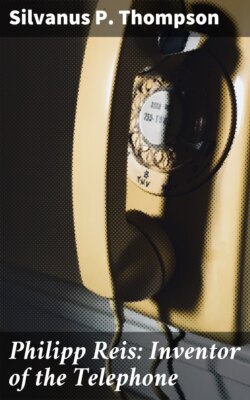Читать книгу Philipp Reis: Inventor of the Telephone - Silvanus P. Thompson - Страница 22
На сайте Литреса книга снята с продажи.
I.—Reis’s Telephone was expressly intended to transmit speech.
ОглавлениеTable of Contents
Reis’s first instrument was (see p. 16) nothing else than a model of the mechanism of the human ear. Why did he choose this fundamental type which runs through all his instruments from first to last? The reason is given in his own first memoir (p. 51), “How could a single instrument reproduce at once the total actions of all the organs operated in human speech? This was ever the cardinal question.” Reis constructed his instrument therefore with intent to reproduce human speech. For this reason he borrowed from the ear the suggestion of a tympanum. Of the operation of the tympanum he had the most exact and perfect conception. He says (p. 54), “Every tone, and every combination of tones”—and this includes articulate tones, of course, and is just as true of them as of any other kind—“evokes in our ear, if it enters it, vibrations of the drum-skin, the motions of which may be represented by a curve.” And further: “As soon, therefore, as it shall become possible, at any place and in any prescribed manner, to set up vibrations whose curves are like those of any given tone, or combination of tones, we shall then receive the same impression as that tone or combination of tones would have produced upon us.” Again, it is clear that his study of acoustics led him to employ the tympanum, because of its special value in responding to all the complex vibrations of human speech. It is no less significant that when a decade later Varley, Gray, and Bell, set themselves to invent tone-telephones for the purpose of multiple telegraphy, they abandoned tympanums as being unsuitable for tone-telephones, and in lieu thereof employed vibrating tongues like those of tuning-forks. Reis’s use of the tympanum had a very definite meaning then; it meant nothing less than this: I intend my instrument to transmit any sound that a human ear can hear. That it was explicitly within his intention to transmit speech is confirmed by another passage of his first memoir (p. 58), wherein he remarks with a shade of disappointment that though “the consonants are for the most part tolerably distinctly reproduced, the vowels are not yet to an equal degree.” To his own pupils and co-workers he communicated his ideas. One of the former, Mr. E. Horkheimer, now of Manchester, expressly says (see p. 117) that Reis’s intention was to transmit speech, and that the transmission of music was an afterthought adopted for the convenience of public exhibition, just as was the case with the public exhibitions of Bell’s Telephone fifteen years later.
Nor did this imperfection cause Reis to hide his intentions from the world. He modestly claimed such success as he had obtained, and left the rest. In 1863 he drew up a Prospectus (given in extenso on p. 85), which was printed to accompany the instruments which were sold; and of which copies are still extant. In this document he says: “Besides the human voice, according to my experience, there can also be reproduced the tones of good organ pipes, from F to c''', and those of a piano.” In this same Prospectus (p. 87) occur the instructions for the use of the signal call by which the listener communicates his wishes to the speaker. Those instructions run: “One beat = sing; two beats = speak.” Can any sane person doubt that Reis intended his instrument to transmit speech, when such directions stand printed in his own Prospectus? Legat’s Report (1862) speaks of Reis’s instrument as intended (see p. 77) to speak, and further describes the use of an elliptic cavity to which the listener can apply his ear. Kuhn (1866) (see p. 106) says that the square-box transmitter (Figs. 17, 18) did not send speech well, and complains that he could only get from it an indistinguishable noise. Doubtless he spoke too loudly, Pisko (1865) speaks of the Reis instrument as intended for speaking (p. 105). Further, in the letter which Reis wrote in 1863 to Mr. W. Ladd, of London, he expressly emphasises by underscoring the word that his Telephone can transmit “any sound” that is sufficiently loud, and he refers to the speaker and listener at the two ends of the line as “the correspondents.” The only reply henceforth possible to any person who shall assert that Reis’s Telephone was not expressly intended to transmit articulate speech is the good honest retort: impudentissime mentiris.
